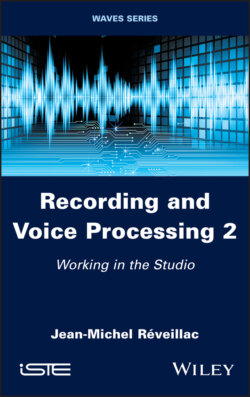Recording and Voice Processing, Volume 2

Реклама. ООО «ЛитРес», ИНН: 7719571260.
Оглавление
Jean-Michel Reveillac. Recording and Voice Processing, Volume 2
Table of Contents
List of Illustrations
List of Tables
Guide
Pages
Recording and Voice Processing 2. Working in the Studio
Preface
Target audience
Structure and contents of the book
Conventions
Vocabulary and definition
Acknowledgments
Introduction
1. Processing Hardware and Software
1.1. The materials
1.1.1. The compressor
1.1.1.1. The ratio
1.1.1.2. The attack
1.1.1.3. The release
1.1.1.4. Gain compensation
1.1.1.5. Optional features
1.1.1.6. Some compressors
1.1.2. The equalizer
1.1.2.1. The graphic equalizer
1.1.2.2. The parametric equalizer
1.1.2.3. The semi-parametric equalizer
1.1.2.4. Some equalizers
1.1.3. Reverberation and delay
1.1.3.1. Principle of reverberation
1.1.3.2. Types of reverberation
1.1.3.3. The parameters of the reverberation
1.1.3.4. Some reverberations
1.1.4. The de-esser
1.1.4.1. Principle
1.1.4.2. Some de-essers
1.1.5. The expander
1.1.5.1. Parameters and principle
1.1.5.2. Some expanders
1.1.6. The exciter or enhancer
1.2. The software
1.3. Conclusion
2. Configuration and the Audio System
2.1. The capture and processing chain
2.1.1. Minimum configuration
2.1.2. Classic home studio configurations
2.1.3. Semi-professional configurations
2.2. Microphone preamplifiers
2.2.1. Tube preamplifiers
2.2.2. Transistor preamplifiers
2.2.3. Hybrid preamplifiers
2.2.4. Channel strips
2.2.5. The right choice
2.2.6. A selection of preamplifiers
2.3. Digital audio interfaces
2.4. Multi-channel headphone amplifiers
2.5. Monitoring speakers
2.5.1. Genelec 8000 series
2.5.2. Yamaha NS10-M
2.5.3. Scientelec ORTF
2.5.4. Studer series A
2.5.5. Elipson LA 4240
2.5.6. Focal Twin6 Be
2.5.7. NHT M-100
2.5.8. JBL 4310
2.5.9. Adam Audio AX series
2.5.10. Selecting active proximity speakers
2.5.11. A word about subwoofers
2.5.12. To conclude on the speakers
2.6. Amplifiers for passive speakers
2.6.1. Yamaha A100
2.6.2. Studer A68
2.6.3. Amcron DC 300A
2.6.4. Amcron D75
2.6.5. Yamaha PX3
2.7. Monitoring controllers
2.8. Conclusion
3. Voice Recording
3.1. Artist, comfort and environment
3.2. The choice of microphone
3.2.1. The location
3.2.1.1. The correct placement area
3.2.1.2. Use of acoustic panels
3.2.1.3. Omnidirectional microphone
3.2.1.4. Cardioid microphone
3.2.1.5. Bidirectional microphone
3.2.1.6. Alternative solution, booth simulation
3.2.1.7. Construction of acoustic panels
3.2.1.8. Acoustic screens
3.2.2. Microphone collection
3.2.3. Style and voice
3.2.4. Direction and color
3.3. Constraints and accessories
3.3.1. Nearby environment
3.3.2. Microphone suspension
3.3.3. Pop filter
3.3.4. Microphone stand and bracket
3.4. Positioning the microphone
3.5. Feedback
3.5.1. Voice feedback through headphones
3.5.2. Voice feedback through loudspeakers
3.5.3. Feedback and audio interface
3.5.3.1. Focusrite Scarlett 2i2
3.5.3.2. Solid State Logic SSL 2+
3.6. The voice-only mix
3.6.1. A mix for which voice?
3.6.2. Comping
3.6.3. Editing and editing
3.6.4. Level balancing
3.6.5. Equalization
3.6.6. Sibilance suppression
3.6.7. Serial compression
3.6.8. Tone adjustment
3.6.9. Delay or reverberation
3.6.10. To finish with the voice-only mix
3.7. Recording multiple performers
3.8. Recording a choir
3.9. Recording a voice-over
3.10. Conclusion
4. Special Effects
4.1. The vocoder
4.2. The talkbox
4.3. Auto-tune
4.4. Melodyne
4.5. Voice processors
4.6. Finally
Conclusion
Appendix 1. Sound Unit. A1.1. Introduction
A1.2. Bel and decibel
A1.3. The different variants of the dB
A1.4. Conclusion
Appendix 2. Audio Connectivity. A2.1. Introduction
A2.2. Coaxial jack
A2.3. XLR plug
A2.4. XLR cables and adapter jacks
A2.5. USB connector
A2.6. Sub-D connector
A2.7. BNC connector
A2.8. RCA connector
A2.9. Toslink connector
A2.10. Conclusion
Appendix 3. Audio Processing Plugins. A3.1. Introduction
A3.2. Compression plugins
A3.3. Equalization plugins
A3.4. De-Esser plugins
A3.5. Delay and reverb plugins
Appendix 4. Microphone Pairs. A4.1. Introduction
A4.2. The AB pair
A4.3. The XY pair
A4.4. The ORTF pair
A4.5. The MS pair
A4.6. The Decca tree
A4.7. The Blumlein method
A4.8. The Faulkner Array
A4.9. The sound-absorbing disk method
A4.10. The artificial head
A4.11. Conclusion
Appendix 5. Types of Software Plugins
Glossary. A
B
C
D
E
F
I
J
L
M
P
Q
R
S
T
U
V
X
References
Hyperlinks
Software publishers
Hardware manufacturers
Talkback
Plugins
Acoustics
Vocoder
Home Studio
Sound effects
Audio filtering
The voice
Audio software tutorials
Interfaces and communication
General sites
Index
A, B
C, D
E, F
G, H
I, J
K, L
M, O
P, Q
R, S
T, U
V, W, X
WILEY END USER LICENSE AGREEMENT
Отрывок из книги
Jean-Michel Réveillac
.....
Each volume can be read separately. While there are concepts that are dependent on another chapter, references to the relevant sections are given. However, the first two chapters of Volume 1, devoted to the history of recording and to the human voice, provide a contextual basis for the understanding of several notions that you will find in the following chapters.
If you’re a novice on the subject, I strongly advise you to read them first, to discover the basics of the subject of this book.
.....